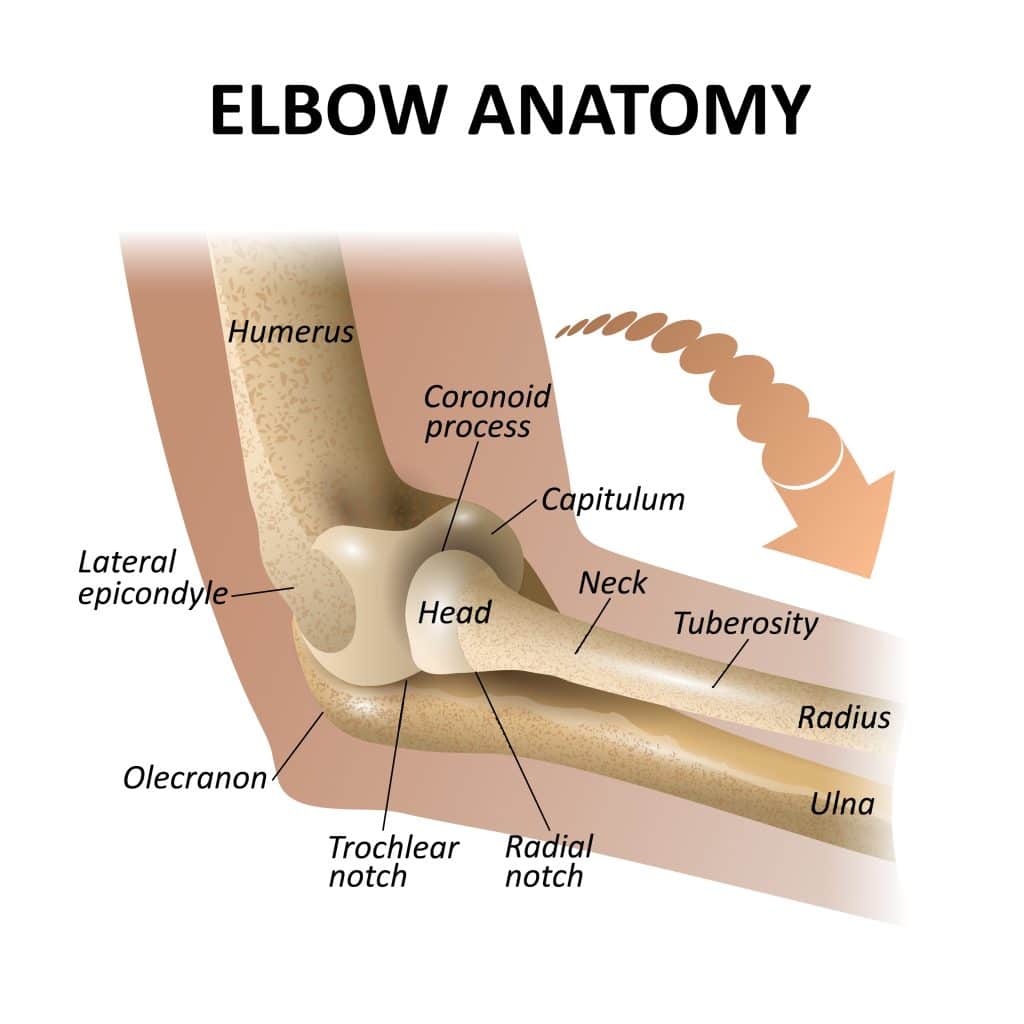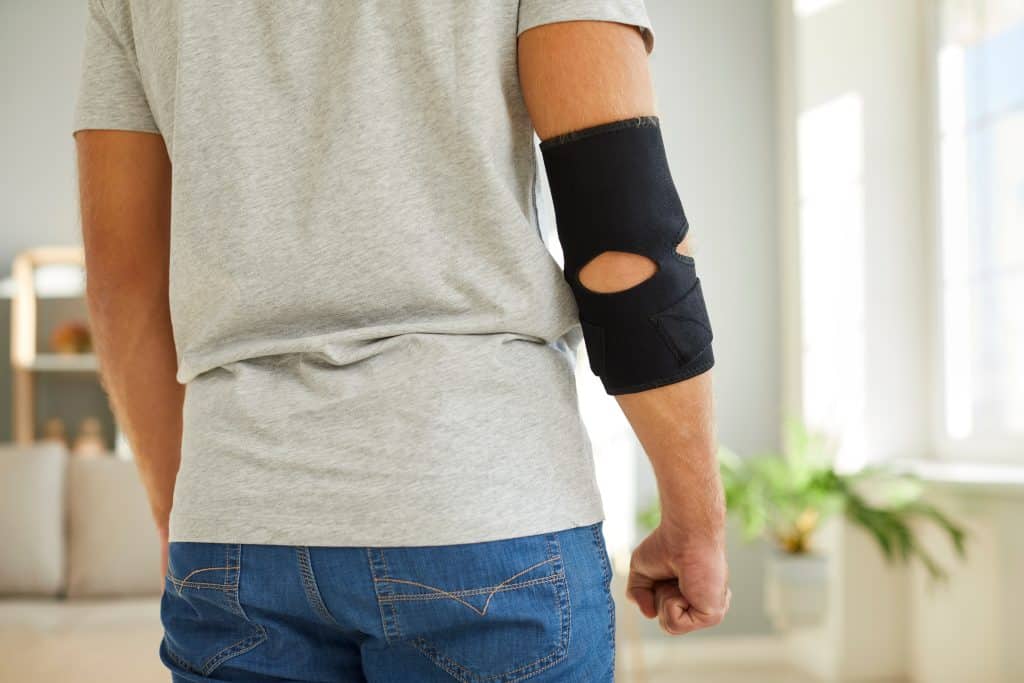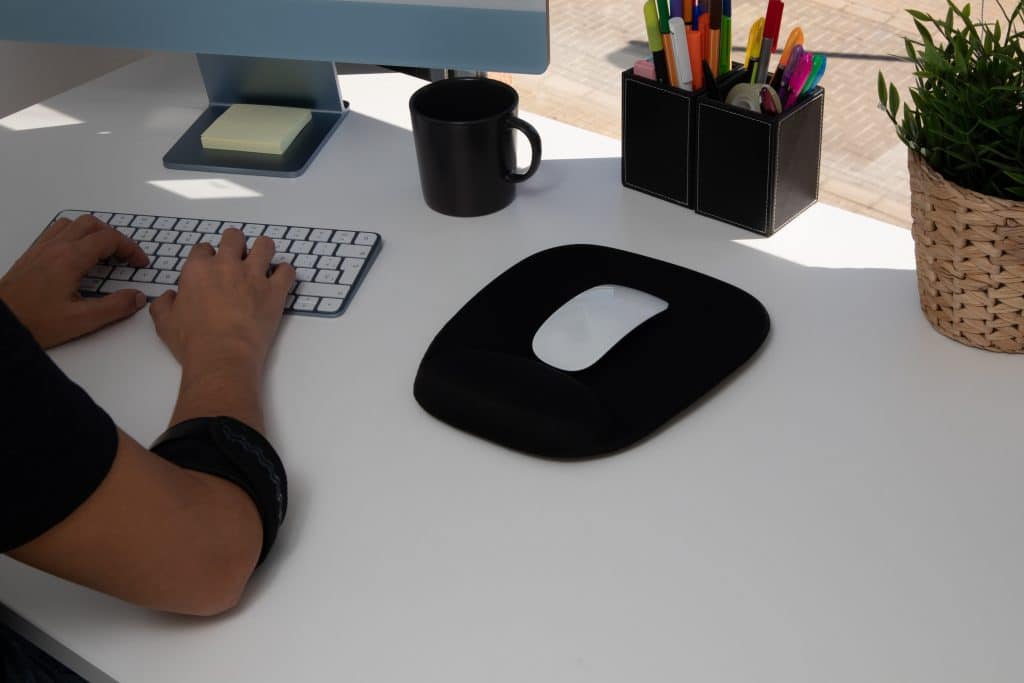Common Causes of Elbow Pain
Acute injuries aside, elbow pain can seem to come out of nowhere. Maybe you noticed it after upping your weight-lifting routine, taking up tennis, or spending more hours than usual swinging a hammer. Perhaps it appeared because you smacked your arm on a door frame, or it got bumped by the drink cart on an airplane. To treat your symptoms, it’s important to find an experienced orthopedic elbow specialist who understands the pain’s underlying cause.
Elbow Anatomy

The elbow joint is where your upper arm (humerus) meets the two bones of your lower arm or forearm (the ulna and radius). This hinge joint allows you to bend your arm and rotate your forearm.
There are two bony parts in your elbow that you can easily feel: the lateral epicondyle on the outside and the medial epicondyle on the inside. The joint’s bones are attached together by ligaments and to surrounding muscles by tendons.
The muscles around your elbow receive communication from your brain through nerves. To straighten your fingers and wrist, your nervous system communicates through the radial nerve on the outside of your elbow. To bend your wrist or fingers, such as when gripping or holding an object, your brain signals muscles via the median nerve along the front of your elbow. The ulnar nerve is on the inside of your elbow, and you use it mainly for the small and precise movements of the hand and fingers. The inner elbow pain and arm tingling you feel when you hit your funny bone comes from pinching your ulnar nerve.
Acute Injury vs. Chronic Elbow Pain

Elbow pain can result suddenly from an acute injury or build up from chronic, repetitive stress over time. Acute elbow pain can be caused by accidents or injuries like a dislocated elbow, fractured elbow, or an elbow strain or sprain. Chronic issues caused by wear and tear to the joint include tendonitis, bursitis, arthritis, stress fractures, and nerve entrapment.
To determine what may be causing your elbow pain, your orthopedic elbow specialist will talk to you about your symptoms and injuries, perform an exam, and take an X-ray. They may need a CT scan, MRI, or nerve conduction test to see any issues in your soft tissues or nerves.
Elbow Pain Causes and Symptoms
Much of the elbow joint pain people complain about is a result of overuse. Many activities — both for work and fun — require you to repetitively use your arm, hand, and wrist. Thus, pain that’s initially sporadic can become near-constant over time. Overuse can cause inflammation in the tendons (tendonitis), felt as tenderness in the elbow and pain in the upper and lower arm.
Common symptoms of elbow overuse include:
- A dull, aching sensation in the elbow
- Tenderness to touch
- Pain when opening the hand or closing it to grip or make a fist
- Difficulty grasping things, particularly when the arm is straight
Tennis Elbow vs. Golfer’s Elbow
Tennis elbow and golfer’s elbow are conditions that arise from tendon inflammation, with tennis elbow being the most common cause of pain in the elbow. This type of tendonitis affects tendons on the outside of the elbow, and golfer’s elbow affects tendons on the inside. Though these conditions can affect anyone and result from any sport or activity that causes elbow overuse, they are most common in people between 40 and 50.
Both conditions are typically caused by repetitive wrist and hand motions, such as those used when gripping and twisting. Repetitive actions involving lifting weights can also cause these issues. People with either of these conditions typically feel tenderness on the outside or inside of the elbow and pain that ranges from mildly uncomfortable to activity- and sleep-disrupting. These conditions can take months to years to resolve and can be recurring, though they rarely require surgery.
Elbow Bursitis

Elbow bursitis, also known as olecranon bursitis, is a condition that affects the bursae (fluid-filled sacs) of the elbow. Pressure or friction on the back of the elbow, like that caused by leaning on a desk or the arm of a chair, can cause the bursae to become inflamed. Common symptoms of olecranon bursitis include swelling, pain, and decreased elbow mobility. Sometimes these inflamed bursae become infected, requiring antibiotics and a procedure to drain them called aspiration.
Nerve Entrapment
If a nerve in the elbow joint becomes compressed or trapped, it can cause elbow pain. Squeezing elbow nerves may also lead to pain, tingling, numbness, and weakness in the forearm, wrist, or hands. Cubital tunnel syndrome and radial tunnel syndrome are two types of compression syndromes that affect the nerves in the elbow.
Cubital tunnel syndrome affects the ulnar nerve, which is the nerve that runs along the inside of the elbow. Most people with cubital tunnel syndrome notice tingling, numbness, or weakness in their ring or pinky fingers. If left untreated, those fingers can become claw-like.
The symptoms of radial tunnel syndrome are similar to those of tennis elbow. Instead of feeling tenderness on the outside of the elbow, however, it’s typically felt further down on the forearm. This condition is rare and often gets better on its own.
Arthritis and Other Issues
Osteoarthritis is the most common type of arthritis. It’s caused by a loss of the protective layer of cartilage that covers a joint. As the cartilage wears away, bony spurs can form, and fluid can increase in the joint space. This can cause pain, swelling, and stiffness. Most cases of osteoarthritis result from previous injuries to the area, such as a broken bone.
Rheumatoid arthritis can also cause elbow joint pain. Rheumatoid arthritis is an autoimmune condition that makes joints red, hot, swollen, and tender. Psoriatic arthritis, another autoimmune condition, can also cause pain and swelling in the elbow. Red and raised patches of skin with white or silver flakes are also characteristic of psoriatic arthritis.
Gout is most commonly known to affect the big toe joint, but it can also cause elbow pain. Uric acid buildup in the joints causes this condition, making them red, swollen, and painful.
Osteochondritis dissecans is a condition where some cartilage and a bony piece of the elbow break off and die. This painful condition is most common in children and teenagers.
Treating Elbow Pain at Home
Many overuse issues that cause elbow pain respond well to home treatments, including RICE:

- Rest your elbow and take a break from sports, work, or other activities that strain the arm and elbow.
- Ice the area in 20- to 30-minute increments using a wrapped ice pack.
- Compress the area using a bandage wrap or compression sleeve. If you tend to bump your elbow or often rest it on your table or desk, look for a sleeve with an incorporated elbow pad.
- Elevate your elbow above your heart while sitting or sleeping to help with pain and inflammation.
Other pain-relieving methods for elbow pain include non-steroidal anti-inflammatory medications like Advil or ibuprofen and over-the-counter topical creams. If your elbow is not inflamed, a heat pack can also provide relief. Sometimes alternating between heat and ice helps the pain.
How long does it take elbow pain to heal?
As your symptoms begin to lessen, remember that your elbow may need additional support from a brace or sling during some activities. Talk to your orthopedic elbow specialist about returning to work and sports without reigniting your symptoms.
Employ gentle stretches and exercises to keep your elbow from getting stiff and your arm muscles from getting weak. Pay attention to movements that exacerbate the issue and note whether avoiding those things lessens your pain. This may seem simple, but it’s a step many people avoid for the sake of their routine. Failing to let your elbow rest can cause symptoms to flare up rather than heal.
Remember that it can take 6 months to 2 years for some elbow pain to fully resolve, and pain can be recurring. See an orthopedic elbow specialist for pain that’s not improving or if you have tingling, numbness, or weakness in your hand. If you have a fever, cannot move your arm, or think you may have fractured your elbow, go to urgent care or the emergency room.
Some cases of elbow joint pain are caused by issues outside the elbow. These include:
- Weakness of the forearm or shoulder muscles
- Spinal injuries that irritate the nerves that run through the elbow
- Lyme, a disease carried by ticks
More Treatment Options for Elbow Joint Pain

If more conservative treatments don’t work, consider corticosteroid injections, which can be helpful for inflammatory issues like rheumatoid or psoriatic arthritis. Though the injections may cause some initial discomfort, they should provide pain relief for several weeks or months. Unfortunately, steroid injections aren’t appropriate for all types of elbow joint pain, including tennis or golfer’s elbow, as they can cause those conditions to be worse in the long term.
If you have tennis or golfer’s elbow, talk to your orthopedic specialist about PRP (platelet-rich plasma) injections. They’ll be able to answer your questions about the therapy and can discuss their experience using it for reducing pain and increasing joint mobility.
Sometimes elbow joint pain requires surgery. There are several different types of surgeries used for elbow pain. Work with your orthopedic specialist to find the right option for your pain, goals, and lifestyle. Our elbow specialists always aim for the most minimally invasive procedures, but elbow replacement surgery can be life-changing for those who need it.
If you have elbow pain and want to speak with an orthopedic elbow specialist, please contact us or comment below.
Leave a Reply